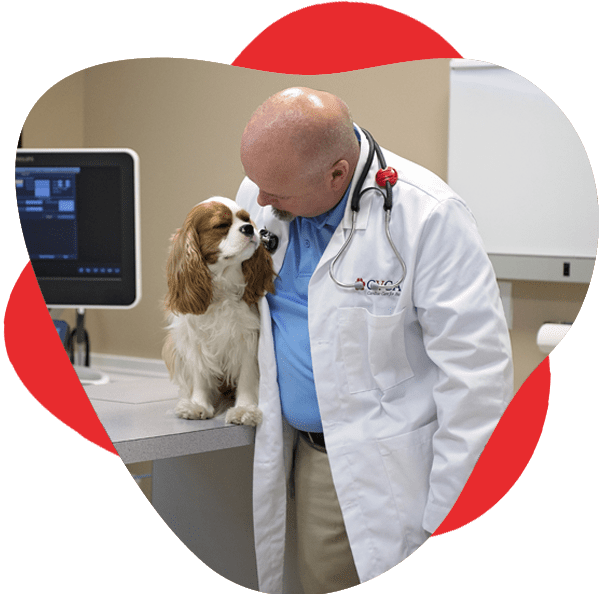How CT Scans For Animals Help Vets Detect Internal Issues Early}
Wiki Article
The Duty of Ultrasound and CT Scan in Modern Veterinary Practices: Insights From Experienced Professionals
In modern vet techniques, ultrasound and CT scans greatly boost analysis capacities. These imaging methods offer crucial insights into animal wellness, leading treatment choices. Experienced professionals recognize the distinct advantages of each modality. Ultrasound offers real-time evaluations, while CT scans supply complex physiological details. Recognizing their roles and applications elevates vital concerns regarding their influence on person results and the future of veterinary diagnostics. What understandings can be gotten from their integrated use?Comprehending Ultrasound in Veterinary Medication
Ultrasound is a vital analysis device in veterinary medicine, supplying a non-invasive technique to envision interior frameworks. This imaging method uses high-frequency sound waves to develop real-time photos of body organs and tissues, permitting veterinarians to analyze problems without surgical intervention. Typical applications consist of assessing the heart, liver, kidneys, and reproductive organs, along with keeping an eye on pregnancies.The procedure is relatively quick and can be executed in different setups, making it an accessible alternative for veterinarians. Unlike radiography, ultrasound provides in-depth info concerning soft cells and blood flow, which is vital for exact diagnoses.Veterinary professionals count on ultrasound to discover abnormalities such as growths, cysts, and fluid accumulation. Its capacity to assist biopsies and various other procedures additionally enhances its energy in clinical technique. By supplying a risk-free and effective way to check out interior anatomy, ultrasound has actually become a cornerstone of contemporary vet diagnostics.
The Advantages of CT Scans for Pet Diagnostics
CT scans deal considerable benefits in veterinary diagnostics by giving improved accuracy in identifying interior conditions (CT Scans For Animals). As a non-invasive imaging technique, they ensure the safety and comfort of pets during examinations. Additionally, CT checks promote a detailed assessment of internal structures, permitting much more efficient treatment planningEnhanced Diagnostic Accuracy
Innovations in imaging modern technology have significantly enhanced diagnostic precision in vet medication, especially via the use of CT scans. These scans provide in-depth cross-sectional images of an animal's inner structures, allowing veterinarians to recognize abnormalities with precision. The high resolution and three-dimensional abilities of CT imaging assist in the detection of conditions such as tumors, cracks, and inner blood loss that may be missed with standard imaging approaches. Additionally, CT scans can assist in pre-surgical preparation by using a detailed view of physiological relationships. This degree of detail not only boosts the accuracy of diagnoses but likewise aids in tailoring reliable therapy plans. As a result, the integration of CT technology right into vet practices is changing the landscape of pet medical care, boosting outcomes for individuals.Non-Invasive Imaging Strategy
The intro of non-invasive imaging techniques has changed animal diagnostics, with CT scans becoming a popular tool in vet practices. These scans supply high-resolution, cross-sectional photos of a pet's internal structures, enabling vets to evaluate complicated problems without the need for invasive treatments. The benefits of CT scans include their ability to identify tumors, fractures, and internal bleeding with impressive accuracy. In addition, they help with the analysis of soft tissues and body organs, enhancing analysis capacities. The rate of CT scanning allows quick decision-making, which is important in emergency circumstances. By reducing tension and pain for the pet, CT scans add to a more gentle approach to diagnostics, inevitably enhancing therapy outcomes and progressing veterinary treatment.Comprehensive Internal Assessment
A complete internal assessment is vital for exact diagnosis and efficient treatment in vet medicine. CT scans offer substantial benefits hereof, providing in-depth cross-sectional photos of an animal's interior frameworks. This innovative imaging technique boosts visualization of intricate physiological areas, allowing veterinarians to identify problems such as tumors, fractures, and inner bleeding with higher accuracy. In addition, CT scans promote the evaluation of conditions that may be testing to diagnose through traditional methods. The speed and precision of CT imaging likewise add to timely treatments, enhancing individual results. As vet practices increasingly incorporate CT technology, the advantages of considerable inner analyses come to be evident, strengthening the relevance of this device in contemporary veterinary diagnostics.Comparing Ultrasound and CT Imaging Techniques
While both ultrasound and CT imaging offer crucial roles in veterinary diagnostics, each strategy provides unique benefits and restrictions that can influence clinical decision-making. Ultrasound is especially valued for its real-time imaging capacities, allowing vets to observe vibrant physiological procedures. This technique is non-invasive, portable, and does not entail ionizing radiation, making it a safer alternative for both pets and clinicians. However, ultrasound may have limitations in envisioning certain physiological frameworks or deep tissues.Conversely, CT imaging gives detailed cross-sectional views of the body, permitting exact localization of irregularities. It masters assessing complex organs and structures, especially in the thorax and abdomen. CT scans need sedation or anesthesia in several cases and include direct exposure to ionizing radiation. Eventually, the option in between ultrasound and CT depends on the specific medical scenario, the area of rate of interest, and the necessity of the diagnostic requirements.Situation Studies: Effective Diagnoses Via Imaging
Case researches illustrate the substantial enhancements in analysis precision achieved through sophisticated imaging modern technologies like ultrasound and CT scans in veterinary techniques. These advancements not only enhance the detection of different problems but additionally facilitate prompt and effective treatment plans. Assessing details cases can highlight the transformative influence of these imaging strategies on vet medication.Diagnostic Accuracy Improvements

Imaging Modern Technology Advancements
As veterinary imaging innovation remains to progress, its effect on analysis capacities ends up being increasingly obvious. Recent study highlight the effective application of sophisticated ultrasound and CT scan methods in determining complicated conditions. For example, a veterinary clinic utilized high-resolution CT scans to detect an uncommon type of lung cancer in a dog, which conventional imaging had actually missed. An ultrasound exam disclosed a stomach mass in a pet cat, prompting prompt medical intervention and a positive end result. These innovations not just improve diagnostic precision but likewise allow veterinarians to devise targeted therapy plans. By leveraging advanced imaging technologies, veterinary professionals are considerably improving individual treatment, leading to extra effective monitoring of numerous health and wellness conditions in pets.
The Role of Imaging in Emergency Situation Veterinary Care
Imaging plays a vital duty in emergency veterinary care, offering vets with important info needed to make fast, informed choices. In urgent circumstances, strategies like ultrasound and CT scans allow practitioners to swiftly examine a pet's interior frameworks, determining critical conditions such as interior bleeding, cracks, or body organ abnormalities. These imaging techniques enable real-time assessments, facilitating timely interventions that can be life-saving. Ultrasound is vital for reviewing soft tissue injuries and conditions like fluid accumulation, while CT checks offer in-depth photos of intricate anatomical structures, important for diagnosing trauma instances. The speed and precision of these imaging techniques boost the vet's ability to devise efficient treatment plans, making certain the very best possible end results for their clients. As a result, the combination hop over to these guys of advanced imaging innovations into emergency situation vet practices is not just beneficial however progressively necessary, as it boosts analysis capabilities and boosts total animal care throughout vital moments.Training and Knowledge in Vet Imaging
Although sophisticated imaging strategies such as ultrasound and CT scans are vital for reliable vet care, the successful execution of these technologies greatly depends on the training and know-how of veterinary experts. Proficient use of imaging devices requires detailed knowledge of composition, pathology, and the concepts underlying each modality. Vet specialists have to undergo specific training to properly translate imaging outcomes, which is vital for identifying problems and intending treatment.Certifications and proceeding education and learning in veterinary imaging improve the abilities of professionals, enabling them to remain updated with technological improvements. Collaboration between radiologists and vets often brings about improved analysis accuracy, as specialists can give understandings into complicated cases. On top of that, useful experience in handling imaging equipment cultivates confidence in its application. Eventually, the top quality of vet imaging solutions is directly associated to the degree of training and expertise had by the professionals utilizing these important diagnostic tools.Future Fads in Diagnostic Imaging for Animals
With the quick improvements in innovation, veterinary analysis imaging is poised for considerable evolution in the coming years. Emerging trends indicate a change towards more portable and easily accessible imaging techniques, such as portable ultrasound devices, which could enhance field diagnostics. Additionally, the combination of man-made intelligence is expected to revolutionize picture analysis, enabling for quicker and much more precise interpretations of results.Moreover, innovations in 3D imaging techniques and calculated tomography will certainly provide veterinarians with more comprehensive sights of animal anatomy, bring about enhanced therapy plans. Digital truth technology might also play a duty in surgical preparation and education and learning, giving vets an one-of-a-kind point of view on complex cases.As telemedicine proceeds to expand, remote appointments helped with by diagnostic imaging will end up being much more usual, permitting specialists to assist general practitioners in real-time. Generally, these patterns are established to enhance the performance and effectiveness of veterinary care, inevitably boosting pet end results.Regularly Asked Concerns
How Much Do Ultrasound and CT Checks Price in Vet Clinics?
The costs of ultrasound and CT scans in veterinary clinics generally range from $300 to $1,500, depending upon aspects such as area, facility kind, and specific procedures required for the animal's medical diagnosis and treatment.
Are There Any Kind Of Risks Connected With Ultrasound and CT Checks for Pets?
Ultrasound and CT scans normally posture minimal dangers to pet dogs. However, potential worries consist of sedation responses and exposure to anesthetics. CT Scans For Dogs. Vets carefully evaluate each situation to minimize any kind of threats associated with these analysis proceduresFor How Long Do Ultrasound and CT Procedures Typically Take?
Ultrasound procedures generally take about 30 minutes to an hour, depending on the intricacy. CT scans, being more comprehensive, normally need half an hour to 90 minutes, including prep work and recuperation time for the pet dog.Can All Veterinarians Perform Ultrasounds and CT Scans?
Not all vets can do ultrasounds and CT scans. Specialized training and qualification are often called for to assure expertise in these sophisticated imaging methods, which may restrict their schedule to veterinarians with additional credentials and sources.What Sorts Of Animals Profit The Majority Of From These Imaging Techniques?
Particular pet types, particularly pet cats and pet dogs, benefit greatly from ultrasound and CT scans. These imaging strategies improve diagnostic precision for conditions like tumors, inner injuries, and body organ abnormalities, leading to better treatment outcomes and individual care. The high resolution and three-dimensional capacities of CT imaging help with the detection of conditions such as tumors, cracks, and internal blood loss that might be try this missed with traditional imaging techniques. Case researches illustrate the significant enhancements in analysis accuracy attained through sophisticated imaging technologies like ultrasound and CT scans in vet techniques. Improving diagnostic precision in veterinary methods has actually been considerably helped by advancements in imaging innovations such as ultrasound and CT scans. Innovative imaging techniques such as ultrasound and CT scans are necessary for effective veterinary care, the effective execution of these technologies heavily depends on the training and knowledge of vet specialists. Vet professionals need to undertake specialized training to precisely translate imaging outcomes, which is essential for diagnosing conditions and planning treatment.Certifications and continuing education in veterinary imaging improve the abilities of experts, Click Here allowing them to remain upgraded with technical advancements.Report this wiki page